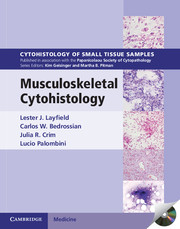Book contents
- Frontmatter
- Contents
- 1 Principles and practice for biopsy diagnosis and management of musculoskeletal lesions
- 2 Ancillary techniques useful in the evaluation and diagnosis of bone and soft tissue neoplasms
- 3 Spindle cell tumors of bone and soft tissue in infants and children
- 4 Spindle cell tumors of the musculoskeletal system characteristically occurring in adults
- 5 Giant cell tumors of the musculoskeletal system
- 6 Myxoid lesions of bone and soft tissue
- 7 Lipomatous tumors
- 8 Vascular tumors of bone and soft tissue
- 9 Pleomorphic sarcomas of bone and soft tissue
- 10 Osseous tumors of bone and soft tissue
- 11 Cartilaginous neoplasms of bone and soft tissue
- 12 Small round cell neoplasms of bone and soft tissue
- 13 Epithelioid and polygonal cell tumors of bone and soft tissue
- 14 Cystic lesions of bone and soft tissue
- Index
14 - Cystic lesions of bone and soft tissue
Published online by Cambridge University Press: 05 September 2013
- Frontmatter
- Contents
- 1 Principles and practice for biopsy diagnosis and management of musculoskeletal lesions
- 2 Ancillary techniques useful in the evaluation and diagnosis of bone and soft tissue neoplasms
- 3 Spindle cell tumors of bone and soft tissue in infants and children
- 4 Spindle cell tumors of the musculoskeletal system characteristically occurring in adults
- 5 Giant cell tumors of the musculoskeletal system
- 6 Myxoid lesions of bone and soft tissue
- 7 Lipomatous tumors
- 8 Vascular tumors of bone and soft tissue
- 9 Pleomorphic sarcomas of bone and soft tissue
- 10 Osseous tumors of bone and soft tissue
- 11 Cartilaginous neoplasms of bone and soft tissue
- 12 Small round cell neoplasms of bone and soft tissue
- 13 Epithelioid and polygonal cell tumors of bone and soft tissue
- 14 Cystic lesions of bone and soft tissue
- Index
Summary
INTRODUCTION
Soft tissue ganglion cysts, Baker’s cysts, and bursae are relatively common. Other cystic lesions are relatively uncommon with simple or unicameral bone cysts representing only 3% of biopsied primary bone tumors, aneurysmal bone cysts representing 2% of primary bone tumors, and telangiectatic osteosarcomas representing only 2% of all osteosarcomas. The wide spectrum of clinical behavior exhibited by these cystic lesions often requires tissue confirmation of the radiographic diagnosis to insure proper management. As these lesions frequently result in acellular aspirates, definitive diagnosis is often impossible cytologically but the finding of an acellular or hypocellular aspirate may be helpful in confirming the radiographic impression of a benign cystic lesion.
Synovial cysts
Clinical features
Synovial cysts most frequently develop around the knee (Baker’s cysts) but are also known to occur in the shoulder, hip, elbow, hand, and ankle. Most present as a mass near a joint and may or may not be painful. Slow enlargement in size is common and may lead to impairment of joint function.
- Type
- Chapter
- Information
- Musculoskeletal Cytohistology , pp. 303 - 313Publisher: Cambridge University PressPrint publication year: 2000

